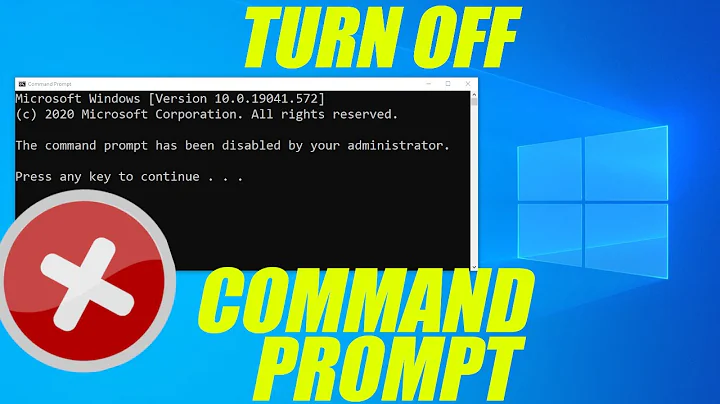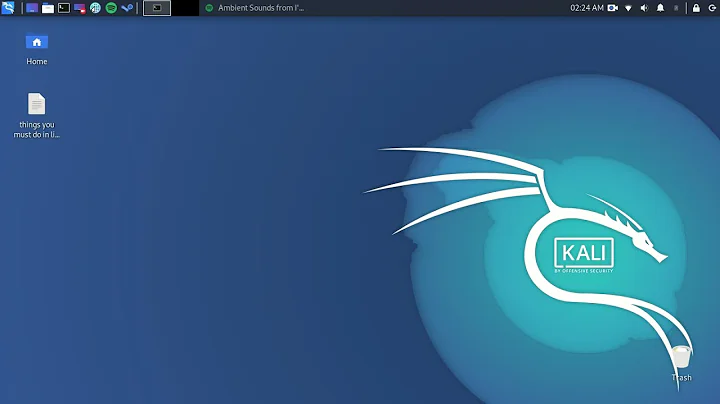How to disable scary terminal commands?
Solution 1
The standard answer is "don't login as root". All commands run as root are scary. If that isn't an option you could put some alias commands into your .bashrc to disable commands you find especially scary. For example:
for scary in shutdown halt reboot rm
do
alias $scary="echo If you really want to do that, type: `which $scary`"
done
Then, if you type shutdown you will get the following message:
If you really want to do that, type: /sbin/shutdown
(Make sure your .bashrc has loaded first, before you try this on a production server)
Quitting your current ssh session and logging in again, or using . ~/.bashrc should load/run .bashrc. Perhaps try running rm without any arguments to make sure your server hasn't disabled automatically loading .bashrc on logins or similar.
Note that if you are primarily concerned with halt and shutdown, you could consider installing molly-guard, which will make you type the hostname before shutting down the machine. This is more useful if you regularly shutdown whole OS'es on the commandline, but want to make sure you are shutting down the right one.
You could also test try this with a less scary command such as logout or exit.
Solution 2
sudo exists for a reason - use it.
When your command (in this case an interactive CLI) is finished, you're dumped back to your user-level shell, not a root shell. There are very few worthy reasons to be in a root shell. (I'm surprised that this isn't already an answer...)
Having said that, don't be a muppet that uses sudo for everything. Understand what you're doing, and understand why it does/doesn't require root privileges.
Additionally you can differentiate your prompt for root / user shells. This also makes it more obvious that you're back at the shell prompt and not "some other CLI". Mine is very colorful, and has lots of useful information (such as the hostname), which makes it very simple to know what host the command will execute on, and also makes it easier to look back through your history and locate prompts - a root shell uses the default prompt.
This is more suitable to use on "your" account, but if you're taking security/sysadminning seriously, then you won't be sharing passwords/accounts, and you won't be sitting in a root shell without being fully aware.
As people have said over, and over, and over again "aliasing commands to make a safe environment is a bad idea". You're going to get comfortable in your safe environment, typing those 'scary' commands where you shouldn't. Then one day you'll change jobs, or login to a new machine, and then boom "whoopsy, I didn't mean to, I'm sorry"...
Solution 3
The package 'molly-guard' (at least on Debian derived systems) will install a wrapper around shutdown, halt, poweroff, and reboot. If it detects that the terminal is a remote one, then it will prompt for the host's name. If it doesn't match, then the command is cancelled.
Solution 4
I accepted an answer that I like a lot, however, if anyone else is reading and want a simpler answer, here is mine.
Find the .bashrc file and put as the last line:
alias shutdown=notforuse
Then when you type shutdown you get something like ~bash: notforuse is not a command
This might be silly but it is simple and it works. I do appreciate answers with better ways to do this however!
Solution 5
The Sudoers file allows a much finer level of granularity than just * 'is allowed to use sudo'*, in particular you can use command aliases to create white lists of groups of commands a particular user or group is restricted to. I have worked with remote servers that were restricted to ssh access and allowed password-less sudo (we did require password protected ssh keys). There are some good reasons for doing this, but it does have dangers, so we used command aliases to allow unrestricted access to things they need to do (restarting servers etc) without granting them privileges for thing they didn't.
There is also syntax to say 'can't run this command'. It can be worked around, so it shouldn't be used as a real security measure but it would work for the scenario you described.
Man sudoers has some good examples on how to set this all up.
Of course this requires using sudo, but that should go without saying.
Related videos on Youtube
MelodiousFires
Updated on September 18, 2022Comments
-
 MelodiousFires almost 2 years
MelodiousFires almost 2 yearsHow do you disable scary terminal commands?
I was using SSH to access a remote Ubuntu server without access to the physical server. I thought I was typing '
shutdown' into the NoSQL server running on the Ubuntu OS, but actually I told the Ubuntu server to shutdown. Then I had to tell the server admin what I did so that he could start up the physical server for me. That was embarrassing!How can I keep this from happening again?
-
 Dmitry Grigoryev about 7 yearsThis has been discussed in lengths, usually with relation to
Dmitry Grigoryev about 7 yearsThis has been discussed in lengths, usually with relation tormwhich has worse side effects thanshutdown. Bottom line: here is no way to prevent bad things from happening if you keep running random commands as root. -
Asklepius M.D. about 7 yearsAs other people have noted regarding aliasing, doing so can make people "get in the habit of a command working in a non-standard way." So does it seem bad to anyone else that the silly NoSQL server uses this command?
-
 MelodiousFires about 7 yearsThe NoSQL server that I was using is Redis.
MelodiousFires about 7 yearsThe NoSQL server that I was using is Redis. -
 alk about 7 yearsJust do not work under the root account.
alk about 7 yearsJust do not work under the root account. -
 Admin about 7 yearsI dare say you learnt the lesson so won't have to feel the need to disable any command again. I'd also add you don't fool-proof GNU/Linux, you just get better than the fool.
Admin about 7 yearsI dare say you learnt the lesson so won't have to feel the need to disable any command again. I'd also add you don't fool-proof GNU/Linux, you just get better than the fool. -
user428517 about 7 yearspermissions .........
-
jmort253 about 7 yearsNot working under root account only works if the passwords are different on different servers. If different servers all have the same passwords, then the wrong system can still be shutdown.
-
William about 7 yearsEver thought about just... Not executing them?
-
-
 isanae about 7 yearsdon't login as root: this won't help if you're confusing the machine you're logged into. I'd suggest changing the prompt to something that would give you a visual cue.
isanae about 7 yearsdon't login as root: this won't help if you're confusing the machine you're logged into. I'd suggest changing the prompt to something that would give you a visual cue. -
TimGJ about 7 yearsAliasing "scary" commands to have a "safe" behaviour is, in my experience, a bad idea. This is because people tend to get in the habit of a command working in a non-standard way which can make them do some very regrettable things when they are on a vanilla system. Simple answer is to tread very carefully when logged in as root.
-
 marcellothearcane about 7 yearswhat about other (arguably more scary) things like
marcellothearcane about 7 yearswhat about other (arguably more scary) things likerm -rf /? -
 Peter - Reinstate Monica about 7 years@isanae The shortcut I used to open a terminal with ssh to the production server would make the terminal background light red. That made me pay attention.
Peter - Reinstate Monica about 7 years@isanae The shortcut I used to open a terminal with ssh to the production server would make the terminal background light red. That made me pay attention. -
 Brian McCutchon about 7 yearsYou can also use
Brian McCutchon about 7 yearsYou can also use\shutdowninstead of/sbin/shutdownto get around the alias (in bash, at least). -
 Alex Hall about 7 years@marcellothearcane
Alex Hall about 7 years@marcellothearcaneset -umight help with that in some cases, like when writingrm -rf /$SOME_VARIABLE_WHICH_I_THOUGHT_EXISTS_BUT_DOESNT. -
gronostaj about 7 years
sourceis an alias to.and is not supported by all shells. -
 MD XF about 7 yearsHm, I used to do this with
MD XF about 7 yearsHm, I used to do this withrmto troll people -alias rm='echo "You can't use rm!" #' -
 MelodiousFires about 7 years@TimGJ That is very sensible. I wouldn't recommend disabling most commands. When you want to it is nice to know how, just so long as you use discretion.
MelodiousFires about 7 years@TimGJ That is very sensible. I wouldn't recommend disabling most commands. When you want to it is nice to know how, just so long as you use discretion. -
 David Richerby about 7 yearsI think this is a bad idea, for three reasons. First, it's confusing for anybody else who has root access to the machine. Second, it trains you that it's OK to type "shutdown" and hit enter, which means you're likely to make the same mistake on the next system you have root access to. Third, this will become extremely confusing if there's ever a valid command called
David Richerby about 7 yearsI think this is a bad idea, for three reasons. First, it's confusing for anybody else who has root access to the machine. Second, it trains you that it's OK to type "shutdown" and hit enter, which means you're likely to make the same mistake on the next system you have root access to. Third, this will become extremely confusing if there's ever a valid command callednotforuseon the path. -
rackandboneman about 7 yearsTry working as root with two or three screens worth of clusterssh, smallest readable font.Then you'll know what scary is.
-
 Tico about 7 yearsI'm with @DavidRicherby on this one. Not a good idea.
Tico about 7 yearsI'm with @DavidRicherby on this one. Not a good idea. -
Wayne Werner about 7 years@isanae I read recently about someone whose production root shell was a nice 5-line ascii art warning that it was a root terminal on production. I'm a fan of that kind of thing.
-
ivan_pozdeev about 7 years
-
ivan_pozdeev about 7 yearsNo, it's about "using
sudofor everything". -
 terdon about 7 yearsAlso note that while Debian and, by extension, Ubuntu have the defaullt
terdon about 7 yearsAlso note that while Debian and, by extension, Ubuntu have the defaullt~/.bash_profilesource.bashrc, that isn't standard behavior and on most systems,.bashrcis not read when logging in via ssh, so this won't make a difference there. It is far better to add the aliases to~/.profileor~/.bash_profileinstead. -
chepner about 7 years@terdon Aliases aren't inherited by child processes, and they are intended to be used in interactive shells.
.bashrcis exactly where they belong. It's a good idea to add something like[[ $- = *i* ]] && source .bashrcto the end of.bash_profileto ensure.bashrcis sourced for interactive login shells. -
Tim about 7 years@isanae I have the .bashrc change the colour of the terminal when I ssh in.
-
 Jonas Schäfer about 7 years@isanae So much that. I once sat next to someone who accidentally forkbombed a production server while they thought they were using their own machine… That was a slow and painful realisation. And the reason why I have
Jonas Schäfer about 7 years@isanae So much that. I once sat next to someone who accidentally forkbombed a production server while they thought they were using their own machine… That was a slow and painful realisation. And the reason why I have☢prod☢in red on the right side of prompts on production servers :) -
 Mr Lister about 7 years@TimGJ I don't get how an error message like "you cannot use shutdown" when you type shutdown gets people in the habit of typing shutdown.
Mr Lister about 7 years@TimGJ I don't get how an error message like "you cannot use shutdown" when you type shutdown gets people in the habit of typing shutdown. -
Joe about 7 years@MrLister : The problem is when people get in the habit of expecting hand holding, and they come across a system where it hasn't been done. Decades ago, I worked for our university's main computing center, and we did no such hand-holding. The engineering department had aliased
rmtorm -i. So someone came along, and typedrm *, thinking it would prompt them for which files to delete .... and lost everything in that directory. -
TimGJ about 7 years@MrLister The question was about scary commands in general, not shutdown specifically. So I have some across some sites which alias
rmrorm -i. Dumb. -
Barmar about 7 yearsWouldn't he have the same problem with
sudo shutdown? If he executes it on the wrong machine, it will still be a disaster. -
Attie about 7 yearsYes, but at least he's expecting it to work... Running a command like that on "the wrong machine" is a mistake that is trivial to avoid...
-
 terdon about 7 years@chepner yes, of course they are not inherited and are meant to be used in interactive shells (well, that's tweakable, but never mind). That's no reason to have
terdon about 7 years@chepner yes, of course they are not inherited and are meant to be used in interactive shells (well, that's tweakable, but never mind). That's no reason to have.bashrcsource.profile. There are very good reasons to keep the two separate and I dislike this new trend that has them joined. -
chepner about 7 yearsYou have my suggestion backwards.
.bash_profileshould source.bashrc. Further,.profileshouldn't be sourcing anything specific tobash. -
 user about 7 years@marcellothearcane On anything resembling a modern Linux system, that needs
user about 7 years@marcellothearcane On anything resembling a modern Linux system, that needs--no-preserve-rootwhich you are unlikely to type by accident. -
Randy L about 7 yearswho's Molly, I wonder...probably someone's cat.
-
CSM about 7 years@the0ther, a 2 year old kid, who triggered the SCRAM switch on a dinosaur machine, twice in the same day. They folks in the room rigged a cover on the switch. catb.org/jargon/html/M/molly-guard.html
-
Randy L about 7 years@CSM that's some nice computer-nerd anthropology there bud. thanks!
-
Hastur about 7 yearsIf you really want to use the aliases, you can at least put all those scaring command aliases in a file, let we say
~/.SaveMyReputationand add as last line of your.bashrca line as[ -f ~/.SaveMyReputation ] && source ~/,SaveMyReputation. You may want eventually to add an extra lineecho "#Scaring command protected shell, comment the last line of .bashrc and log again to have a full working shell"inside that file. At least you may bring with you this alias file on other machine (it should be.bash_aliases, but in this "deprecated" case is better to use another name). -
 Ray about 7 years@marcellothearcane That's covered by the "don't run as root" advice, since you'll never run that command intentionally, and are likely to be extra careful when typing anything similar. But
Ray about 7 years@marcellothearcane That's covered by the "don't run as root" advice, since you'll never run that command intentionally, and are likely to be extra careful when typing anything similar. Butsudo shutdown -h nowis a perfectly normal thing to type on a laptop and a horrible thing to type on a remote server, so having it check if you are on a remote connection isn't a bad idea. -
Taemyr about 7 years@Barmar Does NoSQL understand the sudo command?
-
Barmar about 7 years@Taemyr
sudois a shell command, it has nothing to do with the database. -
Barmar about 7 years@Attie I thought that was the whole point -- he ran
shutdownon the server when he intended to run it on the client, because he forgot he was in asshshell. He wants to configure something on the server to catch the mistake. -
Attie about 7 years@Barmar - no need - setup a nice prompt like I showed in my answer, then the hostname is in your face. Also, don't run commands like
shutdownin a random terminal... make a fresh one - problem solved. -
 jpaugh about 7 yearsSuch hacks only work if you apply them to every computer you ever log in to... that is often quite impractical, and you won't find out until it's too late: by typing
jpaugh about 7 yearsSuch hacks only work if you apply them to every computer you ever log in to... that is often quite impractical, and you won't find out until it's too late: by typingshutdownon a critical system which does not have your hack. -
 Giacomo Catenazzi about 7 years@jpaugh: yeah, it is an hack, and I use it only for my personal servers, where I often logged in, and terminals remain open for too much time. [Note: I use also different color prompts for my personal machines: remote-root, remote-user, local-root, local-user]. For real servers and remote machine, I avoid root and I go root as little as possible, and for sure, without forgetting to exit from them. Just I'm using the my remotes as "cloud" (before the cloud hype, so handled on the old way).
Giacomo Catenazzi about 7 years@jpaugh: yeah, it is an hack, and I use it only for my personal servers, where I often logged in, and terminals remain open for too much time. [Note: I use also different color prompts for my personal machines: remote-root, remote-user, local-root, local-user]. For real servers and remote machine, I avoid root and I go root as little as possible, and for sure, without forgetting to exit from them. Just I'm using the my remotes as "cloud" (before the cloud hype, so handled on the old way). -
rackandboneman about 7 yearsMuch more annoying is habitually typing "halt" and expecting it to behave like "poweroff" (which it stopped doing on some distributions, eg ubuntu).
-
 Peter Cordes about 7 years@Barmar: Actually I think the OP meant to type it into a NoSQL cmdline program, not into bash. So they wouldn't have typed
Peter Cordes about 7 years@Barmar: Actually I think the OP meant to type it into a NoSQL cmdline program, not into bash. So they wouldn't have typedsudo shutdown, since I assumesudoisn't a NoSQL command. Not being in a root shell would have totally solved that problem and been a very good idea. So would looking at the prompt carefully before running important commands. -
Barmar about 7 yearsYes, I see that now. Sorry for the confusion.
-
 Peter Cordes about 7 yearsIf you're going to do this, make it less confusing by using a name like
Peter Cordes about 7 yearsIf you're going to do this, make it less confusing by using a name likealias shutdown=shutdown-disabled-by-an-alias. (This only addresses the 3rd and most minor problem that @DavidRicherby pointed out.) Although it will still probably only take 2 seconds for the next person to go from seeingnotforuse is not a commandto runningtype -a shutdownand finding the alias, then typingsudo \shutdownto disable alias expansion. (Assuming they hadsudoaliased tosudo='sudo 'so it expands aliases in its first arg). -
 Ruslan about 7 years
Ruslan about 7 years/sbin/shutdownis provided bysystemd-sysvpackage by default, so it's not Ubuntu stupidity, it'ssystemdstupidity, and it comes not from Ubuntu, but from Debian at least, which, in turn, seems to take the wholesystemdmovement from Red Hat. When blaming, blame the correct entity — not just the one you dislike. -
valbaca about 7 years"Make sure your .bashrc has loaded first," can .bashrc have something like echo "Safety turned on for $scary commands"?
-
 Dmitry Grigoryev about 7 yearsThis
Dmitry Grigoryev about 7 yearsThismaybething seems to be broken by design: stubbing some syscalls with no-ops is going to crash any non-trivial program which relies on these syscalls to succeed. -
wojciech_rak about 7 yearsTried that, not working. I entered
shutdown, stopped for 5 seconds, reread command (aloud!) and I am sure it was correct. Then hit enter and the command just executed. So that didn't disable scary commands, I'm afraid. I will try with this finger hovering thing, maybe the distance was too small/large. -
Kaz almost 7 years@Ruslan Nobody who packages this crap into their distro escapes the blame of stupidity.
-
 Scott - Слава Україні almost 7 yearsIf you're going to link to a
Scott - Слава Україні almost 7 yearsIf you're going to link to asudocartoon, link to the original, definitivesudocartoon (at xkcd, of course).






